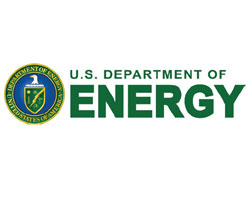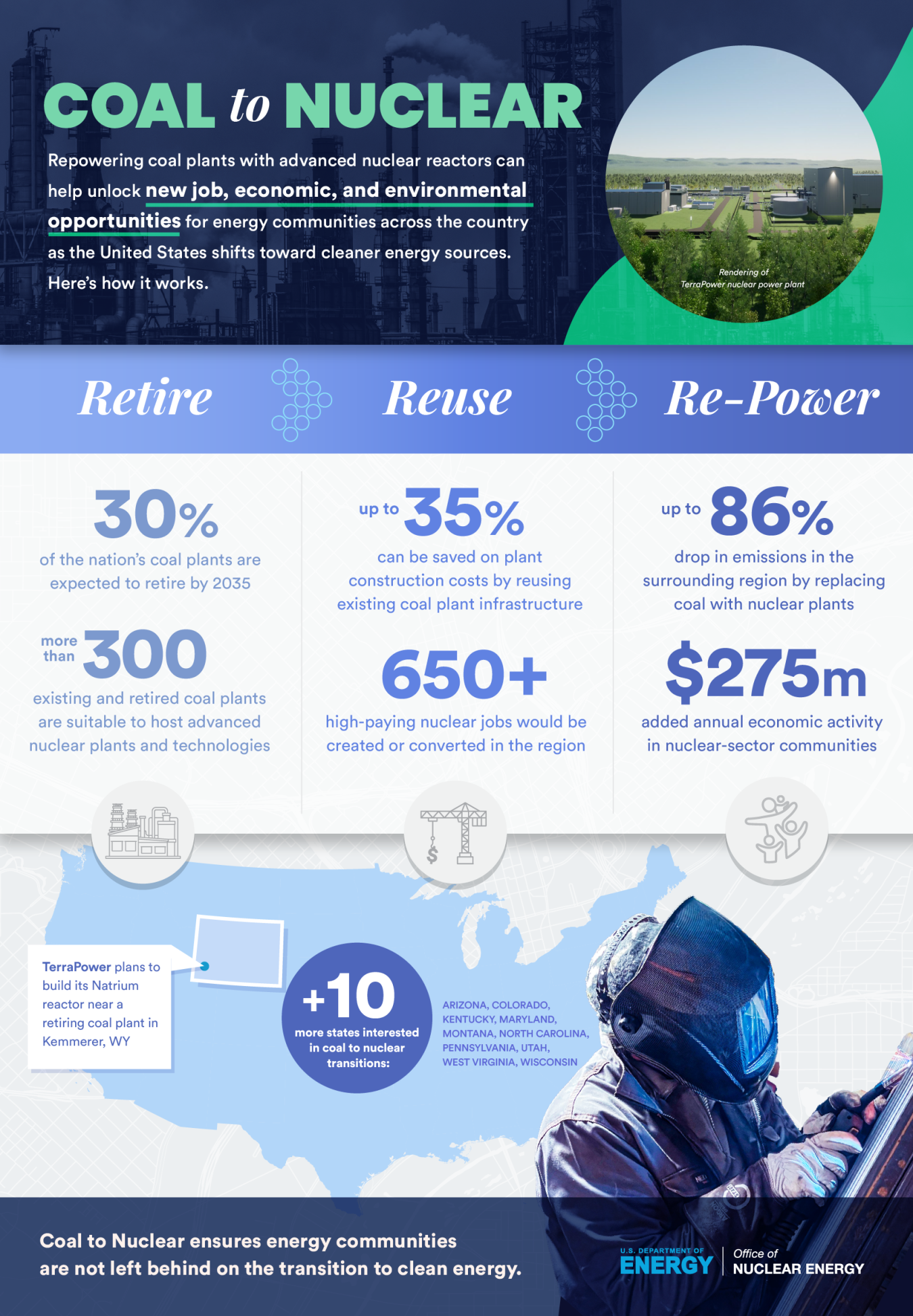
 



.gif)






|
Signature Sponsor


March 6, 2024 - Nearly 30% of the nation’s coal-fired power plants are projected to retire by 2035 as states continue to prioritize a shift toward cleaner energy sources. But with power demands expected to rise due to the electrification of more cars, appliances, and processes, something must help fill the void. The U.S. Department of Energy (DOE) projects we’ll need an additional 200 gigawatts (GW) of nuclear capacity to reach net-zero emissions by 2050 and some of that could take place at or near retiring coal plants — creating new job and economic opportunities for these energy communities. Here are 8 things you should know about transitioning coal stations to nuclear power plants. 1. The Majority of U.S. Coal Plants Could Be ConvertedA 2022 DOE report found that more than 300 existing and retired coal power plant sites are suitable to host advanced nuclear power plants. Each plant could match the size of the site being converted and help increase nuclear capacity by more than 250 GW—nearly tripling its current capacity of 95 GW. 2. Coal to Nuclear Transitions Could Preserve and Create New Jobs According to the same study, employment in the region associated with an incoming nuclear plant could increase by more than 650 permanent jobs spread across the plant, supply chain, and surrounding community. Occupations seeing the largest gains include nuclear engineers, security guards, and nuclear technicians. The plants could also leverage the existing coal plant workforce in the community to help transition their current skills and knowledge to work in nuclear energy with wages that are typically 50% higher than those of other energy sources. 3. Converting Coal Plants to Nuclear Could Drive Economic Growth The study also indicates that long-term job impacts of a converted coal to nuclear power plant could lead to additional annual economic activity of $275 million. This includes a 92% increase in tax revenue from the new nuclear plant for the local county when compared to prior tax revenue from a coal plant. These tax payments would also increase the amount of money available to improve local schools, infrastructure projects, and public services. Additional benefits would also be distributed throughout the community as the wages from good-paying nuclear energy jobs lead to increased household spending. Local businesses may also benefit as suppliers of goods and services in support of plant operations, while others may benefit from increased household spending in the community. 4. Coal to Nuclear Transitions Could Bring Environmental Benefits According to the U.S. Energy Information Administration, coal plants account for 20% of the nation’s total energy-related carbon dioxide emissions. Replacing unabated coal combustion with fission, a physical process that doesn’t emit carbon, would dramatically reduce green gas emissions in the energy sector. It would also directly improve the air quality in the region by avoiding other harmful byproducts produced by fossil fuel plants that are linked to asthma, lung cancer, and heart diseases — helping to improve the over health of the community. 5. Converting Coal Plants to Nuclear Could Save on New Construction Costs The DOE report also found that new nuclear power plants could save up to 35% on construction costs depending on how much of the existing site assets could be repurposed from retired coal power plants. These assets include the existing land, the coal plant’s electrical equipment (transmission connection, switchyard, etc.) and civil infrastructure, such as roads and buildings. 6. Many States are Considering a Coal to Nuclear Transitions Interest in repurposing coal sites is growing. TerraPower plans to build its Natrium reactor near a retiring coal plant in Kemmerer, WY with funding support from President Biden’s Bipartisan Infrastructure Law. In addition to Wyoming, 10 other states have publicly expressed interest in repurposing their coal sites with nuclear energy. These states include: Arizona, Colorado, Kentucky, Maryland, Montana, North Carolina, Pennsylvania, Utah, West Virginia, Wisconsin. The interest level varies from state to state and comes from different stakeholders such as state and local governments, transition planning groups, economic development agencies, and community members. 7. Coal to Nuclear Transitions Help Ensure Communities are Not Left BehindSiting new nuclear power plants in coal communities is one way of ensuring that coal power plant workers and their communities are supported as their power plants retire. In January 2021, the Biden-Harris administration signed an executive order to create an Interagency Working Group on Coal and Power Plant Communities and Economic Revitalization. This initiative honors the coal, oil, natural gas, and power plant workers and communities who have been essential to the growth of the United States. It also ensures that none of these workers or communities are left behind as the U.S. transitions to clean energy sources. 8. There is Help to Prepare for Coal to Nuclear Transitions The Department’s Gateway for Accelerated Innovation in Nuclear (GAIN) is conducting three feasibility studies to assess different aspects of repurposing coal power plant sites with nuclear power. These studies are specific to the community and utility being studied but have been written with the idea that other potential transitions sites will be able to gain some insight. The studies will hopefully be seen as a jumping off point for similar situated coal sites as they enter their own energy transition journey. The GAIN team can also provide assistance to communities around the country as they consider advanced nuclear in their energy transitions. This assistance can include providing information about nuclear energy plants, transition opportunities, and connecting communities to potential funding opportunities through the interagency working group. Qualifying communities could also apply for technical assistance through DOE’s Communities LEAP program to help shift away from their historical reliance on fossil fuels. GAIN also supports public meetings, group work sessions, and strategizing forums in communities to help them learn more about the energy transition process. If you are interested in working with our GAIN team please email GAINTechAssist@inl.gov.  |
 











|